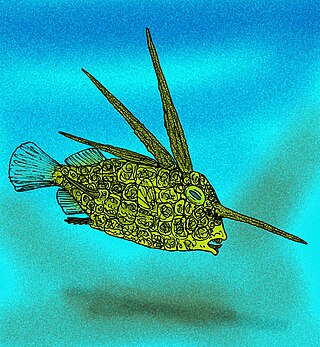
Eospinus daniltshenkoi is an extinct tetraodontid bony fish from the Eocene. Its fossils are from the Danata Formation lagerstatten of Ypresian Turkmenistan.
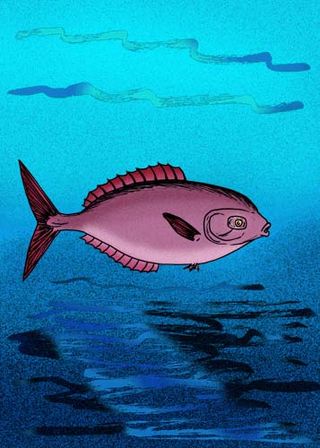
Beerichthys ingens is an extinct prehistoric bony fish that was a member of the Ypresian London Clay fauna of lower Eocene England.
Eothynnus salmonens is an extinct species of prehistoric jackfish that lived during the lower Eocene of what is now the Isle of Sheppey (as a part of the London Clay Lagerstatten. It is known exclusively from some preserved skulls.
Promegalops is an extinct genus of prehistoric bony fish that lived during the lower Eocene.
Protarpon is an extinct genus of prehistoric bony fish that lived during the lower Eocene.
Aulopopsis is an extinct genus of prehistoric marine ray-finned fish that lived during the lower Eocene. It is considered a relative of lizardfish in the order Aulopiformes, but its exact taxonomic placement is uncertain. Some authorities place it with the Aulopidae, while others place it with the Giganturoidae.
Argilloberyx is an extinct genus of prehistoric marine bony fish that lived during the lower Eocene. It contains one species, A. prestwichae, known from the London Clay Formation on the Isle of Sheppey, United Kingdom. It is considered a member of the family Berycidae.
Esocelops is an extinct genus of prehistoric bony fish that lived during the lower Eocene.
Tenuicentrum is an extinct genus of prehistoric bony fish that lived from the early to middle Eocene.
Whitapodus is an extinct genus of prehistoric bony fish that lived from the early to middle Eocene.
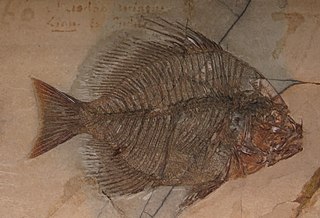
Archaephippus is an extinct genus of prehistoric spadefish that lived from the early to middle Eocene. Several exquisitely preserved fossils have been found from the Monte Bolca lagerstatten.
Haplolepis is an extinct genus of prehistoric ray-finned fish that lived during the late Moscovian Stage of the Pennsylvanian Period. Well-preserved specimens are known from the Lagerstätte in the Upper Freeport Coal at Linton, Ohio, and were first described by John Strong Newberry in the 1800s.
Aglyptorhynchus is an extinct genus of prehistoric marine billfish that was distributed worldwide from the early Eocene to the early Miocene. Fossils are primarily known from the Northern Hemisphere, but one species is also known to have inhabited the waters off New Zealand.
Dalpiazella brevicauda is an extinct prehistoric eel from the Lutetian of the Monte Bolca lagerstatten. D. brevicauda and Paranguilla tigrina constitute the family Paranguilla.
Cylindracanthus is an extinct genus of Cretaceous to Eocene aged ray-finned fish. It is almost exclusively known from bony rostrum fragments as well as some associated teeth, with the rest of the skeleton being cartilaginous. While originally considered to be closely related to billfish, the structure of its rostrum is dissimilar, and is unlikely to be closely related, some later studies suggested closer affinities to the Acipenseriformes. However, this was later rejected due to the lack of osteocytes in histologically examined specimens, which resembles the condition of derived teleosts. A close relation to Blochius has been suggested.
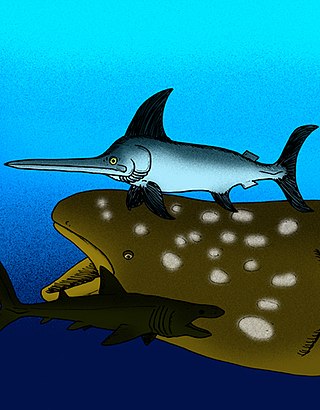
Xiphiorhynchus is an extinct genus of prehistoric swordfish that lived from the Eocene until the Oligocene. Unlike the modern swordfish, both the upper and lower jaws of Xiphiorhynchus were extended into blade-like points.
Proleptolepis is an extinct genus of ray-finned fish belonging to the family Leptolepidae.

Lyrolepis is an extinct genus of prehistoric ray-finned fish found in the Eocene Adaev Formation of Kazakhstan and the Pshekha Formation of Georgia.
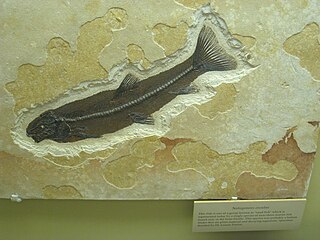
Notogoneus is an extinct genus of prehistoric ray-finned fish. A trace fossil attributed to Notogoneus osculus has been found in the Green River Formation.

Phareodus is a genus of freshwater fish from the Paleocene to the Eocene of Australia, Europe and North and South America.







